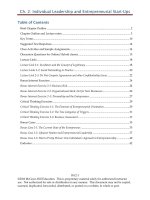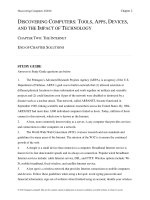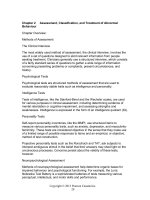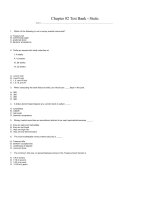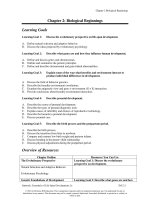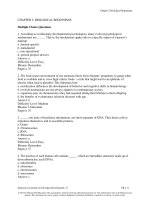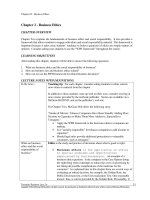Test bank and solution manual of CH02 strategy the totality of decisions (2)
Bạn đang xem bản rút gọn của tài liệu. Xem và tải ngay bản đầy đủ của tài liệu tại đây (2 MB, 43 trang )
Milkovich_PPT_Ch02.pdf
Milkovich_IM_Ch02.pdf
MILKOVICH │ NEWMAN │ GERHART
COMPENSATION
TWELFTH EDITION
Introducing the Pay Model
and Pay Strategy
Chapter Two
Part One
Strategy: The Totality of
Decisions
© 2017 by McGraw-Hill Education. This is proprietary material solely for authorized instructor use. Not authorized for sale or distribution in
any manner. This document may not be copied, scanned, duplicated, forwarded, distributed, or posted on a website, in whole or part.
2–1
Overview
Start with the pay model, and
• assess implications for the total compensation
of your organization’s situation;
• map out the compensation objectives and four
policy choices to achieve them;
• translate policies into the workplace via the
compensation system and implement it;
• reassess by comparing results against the
pay objectives; and
• continue to learn, adapt, and improve.
© 2017 by McGraw-Hill Education. This is proprietary material solely for authorized instructor use. Not authorized for sale or distribution in
any manner. This document may not be copied, scanned, duplicated, forwarded, distributed, or posted on a website, in whole or part.
2–2
EXHIBIT 2.1
Three Compensation Strategies
© 2017 by McGraw-Hill Education. This is proprietary material solely for authorized instructor use. Not authorized for sale or distribution in
any manner. This document may not be copied, scanned, duplicated, forwarded, distributed, or posted on a website, in whole or part.
2–3
Similarities and Differences in
Strategies
In Exhibit 2.1, all companies emphasized
outstanding employee performance.
Different industries may have different pay
strategies, but there can be:
• different strategies within the same industry
such as Google, Microsoft, and SAS, or even
• different strategies within the same company,
for example the Korean company, SK Holdings.
© 2017 by McGraw-Hill Education. This is proprietary material solely for authorized instructor use. Not authorized for sale or distribution in
any manner. This document may not be copied, scanned, duplicated, forwarded, distributed, or posted on a website, in whole or part.
2–4
Strategic Choices
Strategy
The fundamental
directions an
organization
chooses.
Strategic
Perspective
Focuses on those
compensation choices
that help the
organization gain and
sustain competitive
advantage.
© 2017 by McGraw-Hill Education. This is proprietary material solely for authorized instructor use. Not authorized for sale or distribution in
any manner. This document may not be copied, scanned, duplicated, forwarded, distributed, or posted on a website, in whole or part.
2–5
EXHIBIT 2.2
Strategic Choices
© 2017 by McGraw-Hill Education. This is proprietary material solely for authorized instructor use. Not authorized for sale or distribution in
any manner. This document may not be copied, scanned, duplicated, forwarded, distributed, or posted on a website, in whole or part.
2–6
Support Business Strategy
Aligns pay systems with organization's
business strategy.
• Better the alignment, more effective is the
organization.
• Contingency notion:
Changes in business strategies should result in
changes in pay systems.
© 2017 by McGraw-Hill Education. This is proprietary material solely for authorized instructor use. Not authorized for sale or distribution in
any manner. This document may not be copied, scanned, duplicated, forwarded, distributed, or posted on a website, in whole or part.
2–7
EXHIBIT 2.3
Tailor the Compensation System to the Strategy
© 2017 by McGraw-Hill Education. This is proprietary material solely for authorized instructor use. Not authorized for sale or distribution in
any manner. This document may not be copied, scanned, duplicated, forwarded, distributed, or posted on a website, in whole or part.
2–8
Support Business Strategy
Compensation strategies can be based on
generic strategy frameworks.
• Michael Porter’s framework includes:
the cost leadership strategy focuses on reducing
costs, while the
differentiator strategy focuses on providing a unique
and/or innovative product/service at premium prices.
• Miles and Snow’s framework includes:
defenders in stable markets competing on costs, and
prospectors who compete in innovative/new markets.
© 2017 by McGraw-Hill Education. This is proprietary material solely for authorized instructor use. Not authorized for sale or distribution in
any manner. This document may not be copied, scanned, duplicated, forwarded, distributed, or posted on a website, in whole or part.
2–9
Support HR Strategy
Boxall and Purcell use the “AMO theory”
• P (Performance) = ƒ(A, M, O)
Ability, Motivation, Opportunity
• HR systems will be most effective when:
employee ability is developed through selective
hiring and training,
compensation system motivates employees, and
roles allow employees to be involved in decision
making.
© 2017 by McGraw-Hill Education. This is proprietary material solely for authorized instructor use. Not authorized for sale or distribution in
any manner. This document may not be copied, scanned, duplicated, forwarded, distributed, or posted on a website, in whole or part.
2 – 10
EXHIBIT 2.5
Fit Between HR Strategy and Compensation Strategy and
Effectiveness
© 2017 by McGraw-Hill Education. This is proprietary material solely for authorized instructor use. Not authorized for sale or distribution in
any manner. This document may not be copied, scanned, duplicated, forwarded, distributed, or posted on a website, in whole or part.
2 – 11
The Pay Model Guides Strategic
Pay Decisions
The five strategic
compensation
choices are:
• objectives,
• internal alignment,
• external
competitiveness,
• employee
contributions, and
• management.
These decisions, taken
together, becomes the
compensation strategy.
Stated strategies are
written compensation
strategies.
Unstated strategies are
inferred from the pay
decisions.
© 2017 by McGraw-Hill Education. This is proprietary material solely for authorized instructor use. Not authorized for sale or distribution in
any manner. This document may not be copied, scanned, duplicated, forwarded, distributed, or posted on a website, in whole or part.
2 – 12
EXHIBIT 2.6
Key Steps in
Formulating a
Total
Compensation
Strategy
© 2017 by McGraw-Hill Education. This is proprietary material solely for authorized instructor use. Not authorized for sale or distribution in
any manner. This document may not be copied, scanned, duplicated, forwarded, distributed, or posted on a website, in whole or part.
2 – 13
Step 1: Assess Total Compensation
Implications
Business strategy and competitive dynamics
– understand the business.
HR strategy: pay as a supporting player or
catalyst for change?
Culture/values are reflected in the pay
system.
Social and political context is wide ranging.
Employee preferences are also wide ranging.
• Choice is good. Yes, No, Maybe?
Union preferences differ by location.
© 2017 by McGraw-Hill Education. This is proprietary material solely for authorized instructor use. Not authorized for sale or distribution in
any manner. This document may not be copied, scanned, duplicated, forwarded, distributed, or posted on a website, in whole or part.
2 – 14
Step 2: Map a Total Compensation
Strategy
Strategic maps offer a picture of a
compensation strategy.
• They provide a visual reference.
• They are useful for analyzing a strategy as they
are easily understood.
• Strategic maps do not tell which strategy is
“best” but provides a framework and guidance.
Decisions in the pay model work in concert.
© 2017 by McGraw-Hill Education. This is proprietary material solely for authorized instructor use. Not authorized for sale or distribution in
any manner. This document may not be copied, scanned, duplicated, forwarded, distributed, or posted on a website, in whole or part.
2 – 15
EXHIBIT 2.8
Contrasting Maps
of Microsoft and
SAS
© 2017 by McGraw-Hill Education. This is proprietary material solely for authorized instructor use. Not authorized for sale or distribution in
any manner. This document may not be copied, scanned, duplicated, forwarded, distributed, or posted on a website, in whole or part.
2 – 16
Steps 3 and 4: Implement and
Reassess
Step 3 involves implementing the strategy
through the design and execution of the
compensation system.
Step 4 recognizes that the strategy must
change to fit changing conditions, and
involves periodic reassessment.
© 2017 by McGraw-Hill Education. This is proprietary material solely for authorized instructor use. Not authorized for sale or distribution in
any manner. This document may not be copied, scanned, duplicated, forwarded, distributed, or posted on a website, in whole or part.
2 – 17
Source of Competitive Advantage:
Three Tests
• Is it aligned?
• With the business strategy?
• Externally with the economic and sociopolitical conditions?
• Internally with HR system?
• Does it differentiate?
• Does it add value?
• Calculate the return on investment (ROI).
© 2017 by McGraw-Hill Education. This is proprietary material solely for authorized instructor use. Not authorized for sale or distribution in
any manner. This document may not be copied, scanned, duplicated, forwarded, distributed, or posted on a website, in whole or part.
2 – 18
“Best Practices” versus “Best Fit”?
Best Practices
Assumptions:
• A set of best-pay practices
exists.
• Practices can be applied
universally across all
situations.
• Results in better
performance with almost
any business strategy.
Best Fit
An organization is likely
to achieve competitive
advantage if the pay
system:
• reflects the company’s
strategies and values,
• is responsive to employees’
and unions’ needs, and
• is globally competitive.
© 2017 by McGraw-Hill Education. This is proprietary material solely for authorized instructor use. Not authorized for sale or distribution in
any manner. This document may not be copied, scanned, duplicated, forwarded, distributed, or posted on a website, in whole or part.
2 – 19
Guidance From the Evidence
Consistent research evidence show the
following practices matter to objectives:
•
•
•
•
•
internal alignment,
external competitiveness,
employee contributions,
managing compensation, and
compensation strategy.
Identify what practices pay off best under
what conditions.
© 2017 by McGraw-Hill Education. This is proprietary material solely for authorized instructor use. Not authorized for sale or distribution in
any manner. This document may not be copied, scanned, duplicated, forwarded, distributed, or posted on a website, in whole or part.
2 – 20
Virtuous and Vicious Circles
Research indicates that:
• how you pay matters as much as how much
you pay.
• Performance-based pay:
improves performance when combined with highperformance practices, and
can be the best practice under right circumstances.
© 2017 by McGraw-Hill Education. This is proprietary material solely for authorized instructor use. Not authorized for sale or distribution in
any manner. This document may not be copied, scanned, duplicated, forwarded, distributed, or posted on a website, in whole or part.
2 – 21
EXHIBIT 2.9
Virtuous and Vicious Circles
© 2017 by McGraw-Hill Education. This is proprietary material solely for authorized instructor use. Not authorized for sale or distribution in
any manner. This document may not be copied, scanned, duplicated, forwarded, distributed, or posted on a website, in whole or part.
2 – 22
Summary
This chapter showed the similarities and
differences in strategies.
Strategic choices that support business
strategy and HR strategy was discussed.
Next, the chapter looked at developing a
total compensation strategy in four steps.
Finally, the chapter looked at three tests
for a competitive advantage source.
© 2017 by McGraw-Hill Education. This is proprietary material solely for authorized instructor use. Not authorized for sale or distribution in
any manner. This document may not be copied, scanned, duplicated, forwarded, distributed, or posted on a website, in whole or part.
2 – 23
2-1
Compensation – Twelfth Edition
Milkovich │Newman │Gerhart
CHAPTER TWO
STRATEGY: THE TOTALITY OF DECISIONS
Overview
This chapter examines the key aspects of decisions taken during the creation of compensation
strategy. The key premise is that the way employees are compensated can be a source of
sustainable competitive advantage. The three tests to identify if a pay strategy provides
competitive advantage are discussed. The steps involved in developing a total compensation
strategy are described: (1) assessing conditions; (2) deciding on the best strategic choices using
the pay model (objectives, alignment, competitiveness, contributions, and management); (3)
implementing the strategy through the design of the pay system; and (4) reassessing the fit. Two
alternative approaches to developing a compensation strategy are highlighted: (1) “best-fit” and
(2) “best-practices” approach. The best-fit approach presumes that one size does not fit all.
Managing compensation strategically means fitting the compensation system to the business and
environmental conditions. In contrast, the best-practices approach assumes a universal best way
exists. The focus is not on what the best compensation strategy is but on how to best implement
the system and ultimately fit the compensation system to the business and environmental
conditions.
Learning Objectives
Identify and describe similarities and differences in strategies, including different
strategies within the same industry and different strategies within the same company.
Discuss strategic choices that support business strategy and choices that support HR
strategies, included stated versus unstated strategies.
Describe a total compensation strategy in four steps: assess total compensation
implications, map a total compensation strategy, implement strategy, and reassess.
Apply the three tests for sources of competitive advantage: align, differentiate, and add
value.
Compare best practices versus best fit and virtuous and vicious circles.
Lecture Outline: Overview of Major Topics
I.
II.
III.
IV.
V.
Similarities and Differences in Strategies
Strategic Choices
Support Business Strategy
Support HR Strategy
The Pay Model Guides Strategic Pay Decisions
© 2017 by McGraw-Hill Education. This is proprietary material solely for authorized instructor use. Not authorized for sale or distribution in any
manner. This document may not be copied, scanned, duplicated, forwarded, distributed, or posted on a website, in whole or part.

